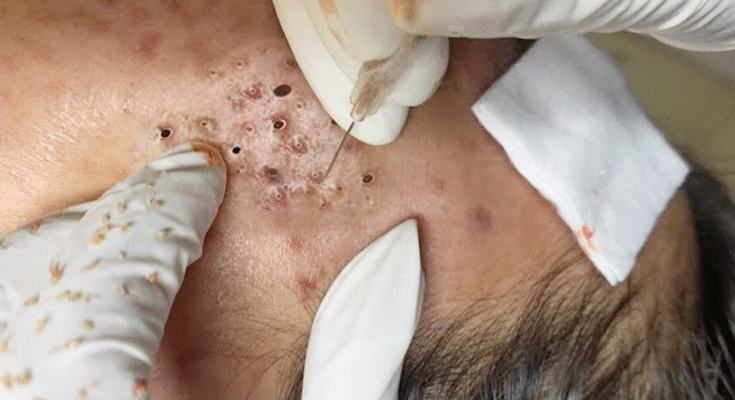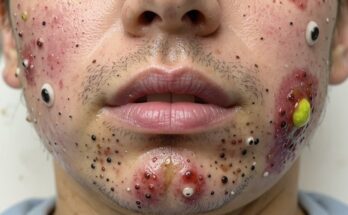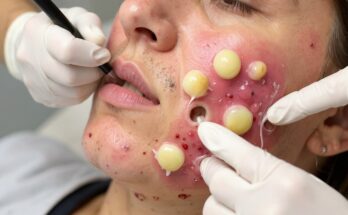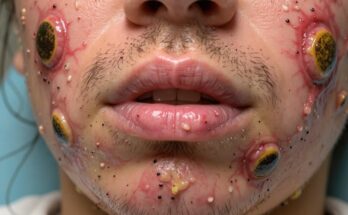Acne can be one of the most frustrating skin concerns to live with. For some people, it starts in adolescence and fades away as they grow older. For others, breakouts persist — or even appear for the first time — well into adulthood.
But here’s the catch: not all acne is the same.
What looks like a cluster of pimples on the surface can have very different causes underneath. And knowing whether your acne is hormonal or regular (non-hormonal) is key to treating it effectively.
While both types share similar symptoms — clogged pores, inflammation, and breakouts — the underlying causes, treatment strategies, and long-term management differ significantly.
This comprehensive guide breaks down how to tell hormonal and regular acne apart, the science behind each, and exactly how to treat them for long-term clear, healthy skin.
1. Understanding Acne: The Basics
Before diving into the differences, let’s revisit what acne actually is and how it develops.
1.1 What Is Acne?
Acne vulgaris is a chronic inflammatory skin condition that occurs when the hair follicles and sebaceous (oil) glands become clogged with sebum, bacteria, and dead skin cells.
The process generally involves four steps:
-
Excess oil production:
Stimulated by hormones (especially androgens) and environmental triggers. -
Clogged pores:
Dead skin cells and sebum form plugs inside follicles. -
Bacterial growth:
Cutibacterium acnes (formerly Propionibacterium acnes) multiplies within clogged pores. -
Inflammation:
The immune system reacts, leading to redness, swelling, and pus.
This cycle results in different types of lesions — from blackheads and whiteheads (comedones) to inflammatory papules, pustules, nodules, and cysts.
2. What Is Regular (Non-Hormonal) Acne?
2.1 The Main Causes
Regular acne, also called “common acne,” is primarily driven by external or local factors rather than hormonal fluctuations.
The main triggers include:
-
Excess oil and bacteria buildup on the skin
-
Poor exfoliation (leading to dead-cell accumulation)
-
Comedogenic skincare products (that clog pores)
-
Environmental factors — humidity, sweat, pollution
-
Lifestyle habits — poor hygiene, diet, or inadequate cleansing
While hormones always play some background role, regular acne is mainly caused by clogged pores and surface-level issues, not internal imbalances.
2.2 Common Characteristics
You’re likely dealing with regular acne if:
-
Breakouts appear anywhere — forehead, cheeks, chest, or back.
-
Pimples vary between whiteheads, blackheads, and pustules.
-
Acne flares with heat, humidity, or makeup use.
-
It responds well to topical treatments (like benzoyl peroxide or salicylic acid).
-
It’s not tied to your menstrual cycle or monthly patterns.
2.3 Types of Regular Acne Lesions
| Type | Description |
|---|---|
| Comedonal Acne | Whiteheads and blackheads; no inflammation. |
| Papulopustular Acne | Red bumps and pus-filled pimples. |
| Mechanical Acne (Acne Mechanica) | Triggered by friction — masks, helmets, tight clothing. |
| Cosmetic Acne | Caused by comedogenic ingredients or heavy makeup. |
2.4 How It’s Treated
Regular acne is typically responsive to topical treatments. A good skincare routine that controls oil, clears pores, and kills bacteria usually works.
We’ll discuss treatments in Section 6 — but first, let’s examine its more stubborn cousin: hormonal acne.
3. What Is Hormonal Acne?
3.1 Root Cause: Hormone Fluctuations
Hormonal acne develops due to imbalances or fluctuations in hormones, particularly androgens (like testosterone), estrogen, and progesterone.
These hormones directly affect sebaceous gland activity, inflammation, and skin cell turnover — making hormonal acne an “inside-out” condition.
3.2 Who Gets Hormonal Acne?
-
Adult women (most commonly between ages 20–40)
-
Teenagers experiencing puberty
-
Women with PCOS (Polycystic Ovary Syndrome)
-
People under chronic stress
-
Those coming off or changing hormonal birth control
3.3 Key Signs of Hormonal Acne
| Characteristic | Hormonal Acne |
|---|---|
| Location | Jawline, chin, and lower cheeks |
| Timing | Flares up before menstruation or during ovulation |
| Lesion Type | Deep, painful cysts and nodules |
| Pattern | Recurrent breakouts in the same spots |
| Response to Treatment | Resistant to OTC products |
| Other Symptoms | Oily skin, irregular cycles, hair thinning, or hirsutism (excess facial hair) |
If your acne flares predictably around your period or worsens with stress, it’s very likely hormonal.
4. Hormones That Influence Acne
4.1 Androgens
-
Increase sebum (oil) production
-
Enlarge sebaceous glands
-
Contribute to clogged pores and bacterial growth
4.2 Estrogen
-
Helps balance oil production and supports skin hydration
-
Acne often worsens when estrogen dips (like before periods or menopause)
4.3 Progesterone
-
Increases sebum viscosity, making pores more likely to clog
4.4 Cortisol (Stress Hormone)
-
Elevates androgen levels indirectly
-
Increases inflammation and delays healing
4.5 Insulin and IGF-1
-
High insulin (from sugar and refined carbs) triggers androgen production
-
Ties diet directly to hormonal acne
5. How to Tell Hormonal Acne and Regular Acne Apart
Here’s a clear, side-by-side comparison:
| Feature | Hormonal Acne | Regular Acne |
|---|---|---|
| Root Cause | Hormone imbalance | External triggers |
| Typical Location | Chin, jawline, neck, lower face | Forehead, nose, cheeks, back |
| Timing | Cyclical (around periods or stress) | Random or constant |
| Lesion Type | Deep cysts and nodules | Blackheads, whiteheads, pustules |
| Skin Type | Oily, congested | Varies |
| Treatment Response | Poor response to OTC | Improves with topical care |
| Common Age Group | 20–40 years (adults) | Teens and young adults |
| Additional Symptoms | Irregular cycles, hair loss, PCOS signs | None usually |
If your breakouts seem unpredictable and surface-level, they’re likely regular acne.
If they’re deep, cyclical, and jawline-focused, hormones are the main culprit.
6. How to Treat Regular Acne Effectively
6.1 Skincare Routine Essentials
-
Cleanser:
Use a gentle, sulfate-free cleanser with salicylic acid (0.5–2%) to unclog pores. -
Treatment:
-
Benzoyl Peroxide (2.5–5%) – kills acne-causing bacteria.
-
Topical Retinoid (Adapalene or Tretinoin) – prevents clogged pores.
-
Niacinamide (5%) – reduces redness and oiliness.
-
-
Moisturizer:
-
Look for oil-free, non-comedogenic products with ceramides or hyaluronic acid.
-
-
Sunscreen:
-
Broad-spectrum SPF 30+ daily to prevent post-acne pigmentation.
-
6.2 Lifestyle Adjustments
-
Clean pillowcases and phone screens regularly.
-
Avoid over-washing — twice daily is enough.
-
Limit sugary and greasy foods.
-
Stay hydrated and manage stress.
6.3 Professional Treatments
-
Chemical Peels (AHA/BHA) – remove dead cells and brighten skin.
-
LED Light Therapy (Blue Light) – reduces bacterial growth.
-
Microneedling – helps with acne scars.
With consistent topical care, regular acne typically improves within 8–12 weeks.
7. How to Treat Hormonal Acne Effectively
Hormonal acne often needs internal regulation in addition to topical treatments.
7.1 Medical Treatments
-
Oral Contraceptives (Birth Control Pills)
-
Contain estrogen + progestin to stabilize hormones.
-
Reduce androgen activity and oil production.
-
Brands like Yaz, Yasmin, and Ortho Tri-Cyclen are often prescribed.
-
-
Spironolactone
-
A potassium-sparing diuretic with anti-androgen properties.
-
Blocks testosterone’s effect on oil glands.
-
Works especially well for women with jawline acne.
-
-
Anti-Androgen Therapy (for PCOS)
-
Regulates excess testosterone and helps restore hormonal balance.
-
-
Metformin (for insulin resistance)
-
Improves blood sugar control and reduces androgen production.
-
7.2 Topical Support
Even with internal treatments, topical products remain essential:
-
Retinoids – normalize cell turnover.
-
Azelaic Acid – antibacterial, brightening, and anti-inflammatory.
-
Niacinamide – balances oil and soothes irritation.
-
Sulfur Masks – control excess sebum and prevent clogged pores.
7.3 Dietary and Lifestyle Habits
-
Reduce sugar and high-glycemic foods — keeps insulin steady.
-
Limit dairy — especially skim milk.
-
Eat more fiber, zinc, and omega-3s — supports hormone detox and reduces inflammation.
-
Exercise regularly — improves circulation and balances hormones.
-
Sleep 7–9 hours per night — regulates cortisol and repair cycles.
7.4 Supplements That May Help
-
Zinc: Regulates oil production and inflammation.
-
DIM (Diindolylmethane): Balances estrogen metabolism.
-
Omega-3: Reduces inflammatory cytokines.
-
Probiotics: Improve gut-skin-hormone connection.
(Always consult a doctor before starting supplements.)
8. How Long Does It Take to See Results?
-
Topical treatments: 6–12 weeks
-
Hormonal treatments (like Spironolactone or birth control): 3–6 months
-
Diet/lifestyle changes: noticeable improvements in 1–3 months
Patience is essential — acne treatments target the skin’s renewal cycle, which takes about 28 days, meaning visible improvement happens gradually.
9. Preventing Acne Recurrence
Whether hormonal or regular, prevention is key.
Daily Habits:
-
Don’t skip sunscreen.
-
Keep your skincare minimal but consistent.
-
Avoid touching or picking pimples.
-
Stay hydrated and manage stress.
Long-Term Strategies:
-
Continue maintenance treatments (like retinoids).
-
Adjust diet for hormone balance.
-
Schedule regular dermatology check-ups.
10. Emotional and Psychological Impact
Acne — especially when chronic — can deeply affect self-esteem and mental health.
Many people experience anxiety, social withdrawal, or even depression.
If acne is taking a toll emotionally, consider:
-
Support groups or counseling.
-
Focusing on non-appearance-based self-care.
-
Remembering that acne is not your fault — it’s a medical condition, not a reflection of hygiene or worth.
11. The Bottom Line: Know Your Acne, Know Your Treatment
| Category | Hormonal Acne | Regular Acne |
|---|---|---|
| Primary Cause | Hormone fluctuations | External/environmental triggers |
| Location | Chin, jawline, lower face | T-zone, forehead, back |
| Lesion Type | Deep cysts and nodules | Whiteheads, blackheads, pustules |
| Response to OTC Treatments | Slow or minimal | Often good |
| Best Treatments | Hormone-regulating meds + retinoids | Topical acids + benzoyl peroxide |
| Prevention Focus | Internal balance | Skin hygiene and barrier health |
12. Key Takeaways
-
Regular acne is typically caused by clogged pores, bacteria, and external factors — and usually responds to topical treatments.
-
Hormonal acne originates internally from hormonal fluctuations and often needs medical or systemic support.
-
The best approach combines consistent skincare, balanced diet, hormonal regulation, and stress management.
-
Above all, acne is treatable — and with patience, evidence-based care, and consistency, clear skin is absolutely achievable.



